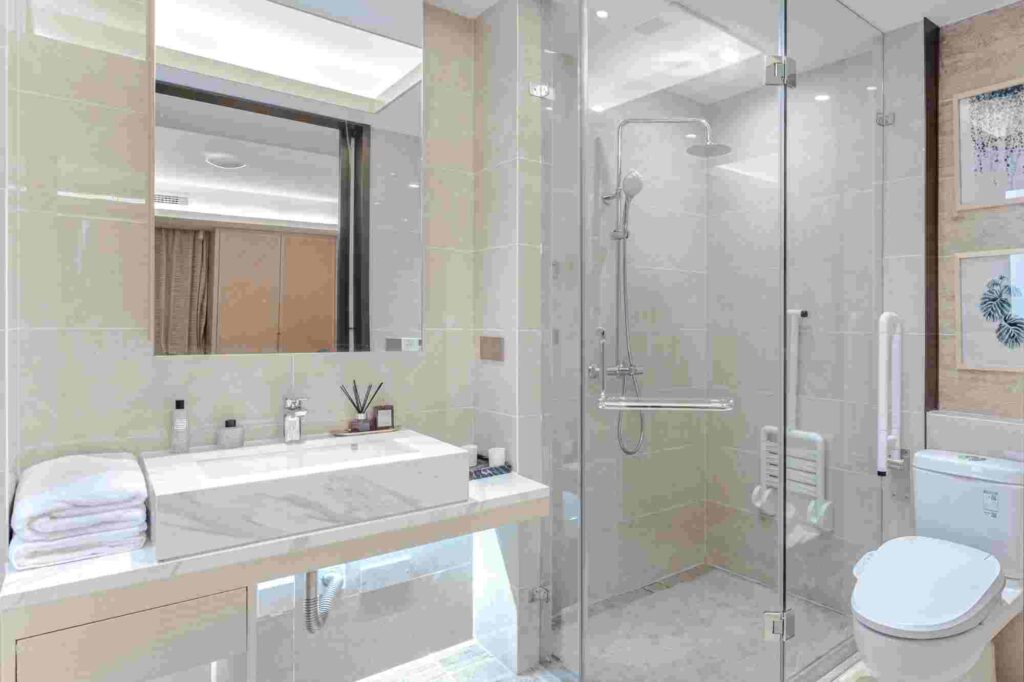A post by the University of South Alabama, citing data from Houzz, reveals that the median bathroom renovation cost in 2023 rose to $15,000, an 11% increase from 2022. One of the key decisions homeowners face during a bathroom renovation is installing baseboard or tiling on bathroom walls. Choosing between these options can significantly impact both the aesthetics and functionality of your bathroom. Whether you prioritize ease of installation, durability, or moisture resistance, understanding the pros and cons of installing baseboard or tiling on bathroom walls is crucial for making the best decision.

Factors to Consider When Choosing Between Baseboards or Tiles for Bathroom Walls
As a homeowner, you might be uncertain about installing baseboard or tiling on bathroom walls. Each option impacts the look, function, and maintenance of your bathroom. Understanding these factors will guide you in choosing the right fit for your space.
Baseboards vs Tiles: Aesthetics of Bathroom Walls
Your bathroom’s design greatly influences the choice between baseboards and tiles. Installing baseboards offers a classic, simple look, while tiling on bathroom walls provides a more modern, sleek appearance.
Baseboards vs Tiles: Functionality
Baseboards are lightweight and easy to install, making them ideal for quick projects. Tiles, however, offer more durability and strength. They can withstand wear and tear better in busy bathrooms.
Think about your bathroom’s usage and traffic. This will help you decide which option suits your needs.
How Moisture Resistance Affects Your Choice Between Baseboards or Tiles for Bathroom Walls
Moisture is a critical factor in bathroom design. If not properly sealed, baseboards can absorb water, leading to mold damage.
Tiles resist water and are better suited for high-moisture areas like showers. Always ensure proper installation to prevent water issues, regardless of your choice.
Maintenance Considerations: Should You Choose Baseboards or Tiles for Bathroom Walls?
Baseboards require regular cleaning and caulking to prevent dirt buildup or gaps. Tiles need grout sealing to prevent stains or cracks.
Cleaning tiles may take more time, but they are often more durable. Evaluate your willingness to handle maintenance before making a decision.
Durability
Baseboards are generally less durable compared to tiles. Tiles are stronger and more resistant to impacts, making them suitable for high-traffic or heavily used bathrooms.
If you want long-term performance, tiles may be the better option. Consider how much wear and tear your bathroom will face over time.
Choosing between baseboards or tiling will help ensure your bathroom meets both functional and aesthetic needs.
Preparing the Wall for Installation
Preparing the wall is a key step for a successful bathroom upgrade. Proper preparation ensures durability and a clean, professional finish. Follow these steps.
Substrate Preparation
Start by cleaning the walls to remove dirt, dust, or grease. Ensure the surface is smooth and leveled to avoid uneven installation.
Moisture barriers are crucial in bathrooms to protect walls from water damage. These steps also create a strong foundation for baseboards or tiles.
Materials for Securing Baseboards
For baseboards, you’ll need:
- Adhesive
- Nails
- A saw for precise cuts
Use caulk to seal gaps and protect against moisture. Choose materials that bond well with your wall type.
Materials for Tiling
For tiling, gather materials like:
- Thin-set mortar
- Tile spacers
- Grout
Use a notched trowel for even mortar applications.
Sealing tile gaps with grout helps protect against water. Grout also adds a polished finish. Proper tools make tiling easier and more effective.
Installation Techniques for Baseboards
Appropriate baseboard installation is key to its longevity. Check out some of these installation techniques that will make your installing of baseboard or tiles easier.
Measure and Mark: Measure the length of each wall. Mark the dimensions on the baseboard pieces.
Cut the Baseboards: Use a miter saw for precise cuts, especially for corners.
Apply Adhesive: Use construction adhesive along the back of the baseboards for secure attachment.
Nail in Place: Drive finishing nails into the baseboards to anchor them.
Seal Gaps: Use caulk to fill gaps between the wall and baseboards for a smooth finish.
Always double-check measurements to avoid errors. Caulking baseboards is crucial for moisture resistance, especially in bathrooms with occasional splashes.
Installation Techniques for Tiling
The right installation techniques prevent potential tile damage. Unlock some of the top tile installation techniques.
Lay Out the Tiles: Arrange tiles on the floor to plan their placement on the wall.
Apply Mortar: Spread thin-set mortar on the wall using a notched trowel for even coverage.
Set the Tiles: Press tiles firmly onto the wall, placing spacers between them for straight lines.
Cut Tiles as Needed: Use a tile cutter for edges and around obstacles like outlets.
Grout the Gaps: Once the mortar dries, remove spacers and fill gaps with grout.
Seal the Grout: Apply a grout sealant to protect against stains and moisture.
Finishing and Maintenance Considerations
Finishing touches improve both the look and durability of your bathroom. For baseboards, smooth out the caulk with your finger for a clean, seamless finish. If needed, paint the baseboards with moisture-resistant paint.
For tiled walls, polish the surface to remove extra grout. Check tiles regularly for cracks and reseal the grout if necessary.
To maintain their appearance, both baseboards and tiles should be cleaned using gentle, non-abrasive products. Fix issues like peeling paint or loose tiles right away to prevent bigger problems.
Troubleshooting Common Issues
Some problems may arise during installation. For baseboards, uneven walls can leave gaps. Sand the wall or use extra caulk to fill these spaces.
For tiles, incorrect mortar application can cause tiles to loosen. Apply an even layer of mortar and check adhesion as you go. Cracked grout is another common issue.
Regular resealing helps prevent damage and maintain the finish. Anticipating these problems ensures a smooth installation process.
Installing Baseboard or Tiling on Bathroom Walls
Choosing between installing baseboard or tiling on bathroom walls depends on your bathroom’s design, functionality, and moisture resistance needs.
Baseboards are simple to install, but they require regular maintenance. Tiles offer durability and a wide range of aesthetic options, especially in high-moisture areas like showers.
Using the right tools is key to a smooth installation for DIYers and professional tile installers. At RUBI, we offer reliable tools designed to improve precision and efficiency, whether you’re working with baseboards or tiles.
Contact us today to learn more about our tools and how they can enhance your projects.





Post a comment